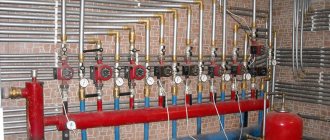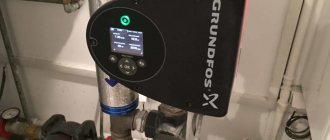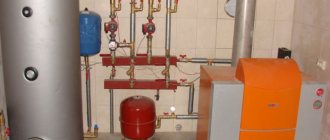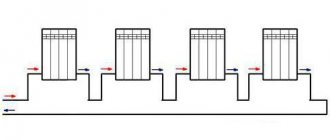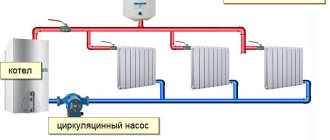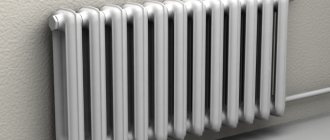Home / DHW
Back
Published: 12/07/2019
Reading time: 3 min
0
4428
If the distance from the boiler to the water intake point is large, DHW recirculation may be required. It is necessary for the constant movement of liquid in the hot water supply circuit.
- 1 Why is recycling necessary?
- 2 Recirculation scheme
- 3 Installation rules
- 4 System shutdown
What is hot water recirculation (DHW) in a private home: diagrams and definitions
This is a supply line - a circuit piping - in which the coolant constantly moves through the system. It is needed to increase efficiency, and therefore the operating efficiency of boilers, which will result in an improvement in the level of consumer comfort.
Its arrangement solves several pressing problems at once. For example, when using it, the liquid does not have time to cool down, since it moves non-stop through pipelines - to the points of intake and back to the heating element (where it is heated) - which allows you to use it at any time, if the need arises, rather than waiting half an hour to take a bath .
In fact, the practical task of any implemented hot water supply scheme with water circulation in the system comes down to ensuring optimal thermal conditions. The temperature of the carrier suitable for operation is constantly maintained, due to which it enters a new cycle with minimal losses, especially since heat is transferred evenly at all stages of consumption.
The simplest wiring option is a ring with a pump that ensures continuous flow movement under pressure. Among its mandatory elements are tees responsible for the return of liquid and installed closer to the point of intake. The shorter the line, the shorter the heating wait time, but also the lower the overall performance.
Now let's turn our attention to solutions for different objects.
DHW circulation diagram in a private house
Here you need to pipe the heater in one or two circuits: most often it is played by a boiler, but a boiler, volatile or not, is also possible.
- The first must be permanently connected to the mains, but it is usually equipped with its own pump for pressurizing.
- The second does not require power from an outlet, but requires a timely supply of firewood or other fuel for combustion.
Using a boiler allows you to implement technically more complex solutions, for example, integrating bathroom and kitchen sink faucets, a heated towel rail and other elements into the line. Yes, as their number increases, energy consumption also increases, but overall savings also increase, which is especially noticeable with active fluid consumption.
Scheme of hot water supply (DHW) recirculation in a multi-storey building
In such cases, not direct, but indirect supply is relevant. The carrier is first heated, then sent to the pipes, passes through them, returns to the heating element, is again brought to the required temperature and goes to the next cycle. Each apartment (room) is a participant in the general wiring, which is characterized by the following features:
- The liquid moves from bottom to top or, much less often, vice versa, but always strictly vertically.
- Power is supplied exclusively from the DHW pipeline, and in the boiler itself, which is constantly running, the environment never cools down.
- The return of the flow is carried out through bends through which it flows back.
Scheme of hot water supply with instantaneous water heater
The following can be used as an instantaneous water heater:
- DHW gas water heater;
- DHW heating circuit of a double-circuit heating boiler;
- electric instantaneous water heater.
- plate heat exchanger connected to the heating circuit.
The instantaneous water heater begins to heat the water at the moment the water is drawn
when the hot water tap is opened.
All energy spent on heating passes from the heater to the water almost instantly, in a very short time of water movement through the heater. In order to obtain water at the required temperature in a short period of time, the design of an instantaneous water heater provides for limiting the speed of water flow. The water temperature at the outlet of the flow-through heater depends very much on the water flow —
the size of the stream of hot water flowing from the tap.
To properly supply hot water to only one shower head, the power of the instantaneous water heater must be at least 10 kW. You can fill a bathroom in a reasonable time using a heater with a power of more than 18 kW
.
And if, when filling the bath or running the shower, you also open the hot water tap in the kitchen, then for comfortable use of hot water you will need a flow heater power of at least 28
kW. To heat an economy class home, a lower power boiler is usually sufficient. Therefore, the power of a double-circuit boiler is chosen
based on the need for hot water.
A DHW circuit with an instantaneous water heater cannot provide comfortable and economical use of hot water in the house for the following reasons:
- The temperature and pressure of water in the pipes very much depend on the amount of water flow. For this reason, when opening another tap, the water temperature and pressure in the hot water system changes greatly.
It is very uncomfortable to use water even in two places at the same time. - When the flow of hot water is low, the instantaneous water heater does not turn on at all and does not heat the water.
To obtain water at the required temperature, it is often necessary to use more water than necessary. - Each time the water tap is opened, the instantaneous water heater starts again. It constantly turns on and off, which reduces its service life. Each time, hot water appears with a delay, only after the heating mode has stabilized. Frequently restarting the heater reduces efficiency and increases energy consumption. Some of the water goes down the drain uselessly.
- It is impossible to recirculate water in the distribution pipes throughout the house. Hot water from the tap appears with some delay.
The waiting time increases as the length of the pipes from the water heater to the water collection point increases.
Some of the water at the very beginning has to be drained uselessly into the sewer.
Moreover, this is water that has already been heated, but has managed to cool down in the pipes. - Scale deposits quickly accumulate
on a small surface inside the heating chamber of an instantaneous water heater. Hard water will require frequent descaling.
Ultimately, the use of an instantaneous water heater in a hot water system leads to an unreasonable increase in water consumption and the volume of sewerage, to an increase in energy consumption for heating, as well as to insufficiently comfortable use of hot water in the house.
The DHW system with instantaneous water heater is used, despite its disadvantages, due to the relatively low cost and small size of the equipment
.
The system works better if a separate individual instantaneous water heater is installed near each water collection point.
In this case, it is convenient to install electric flow heaters. However, such heaters, when drawing water simultaneously in several places, can consume significant power from the electrical network (up to 20 - 30 kW). Typically, the electrical network of a private home is not designed for this, and the cost of electricity is high.
Advantages of a hot water supply system with circulation and its scope
The practical advantages are obvious:
- the stream is at least well warm immediately after opening the tap;
- It’s easy to adjust the temperature by turning the valve and adding a little cold water;
- there is no overspending - precious liters of liquid do not pour into the drain, because you do not wait for it to heat up;
- with constant use there are no traffic jams or clogging of pipes, and if they appear, they are immediately noticeable;
- a large number of end consumers are seamlessly integrated within one solution;
- it can be implemented on the basis of any heater - storage, indirect heating boiler or double-circuit boiler.
Hence the scope of application is clear. Such systems are relevant for one- and multi-story buildings, in which water treatment equipment is installed in a technical room, away from the inhabited rooms, and/or there are several bathrooms and many intake points. They are in demand at facilities with long communication lines and help reduce fluid losses and increase the efficiency of its heating and use.
Attention, this is a global solution, and therefore its implementation (regardless of the topology) is possible at the construction stage or at least a major renovation. It is futile to modernize an existing and standard plumbing complex - too much money will be required, it is cheaper and easier to implement everything from scratch.
MBFT-75 Membrane for 75GPD
SF-mix Clack up to 0.8 m3/h
SF-mix Runxin up to 0.8 m3/h
When circulation in the DHW circuit is necessary
Centralized water heating is the best way to provide hot water in large houses. In this case, the system must necessarily include a storage water heater or an indirect heating boiler used in conjunction with a single-circuit boiler. This is necessary to ensure that a certain amount of hot water is constantly available to consumers. The boiler capacity is determined by the expected water consumption. The water in the boiler is heated to a predetermined temperature by a built-in heating element or from a heat exchanger connected to the boiler. When hot water is not in demand, the system is in standby mode. But when you open a hot water tap, the system turns on, immediately providing a sufficient amount of water. Boiler volumes can range from several tens to several hundred liters. Moreover, unlike instantaneous water heaters, the flow rate is not limited.
However, the centralized hot water system also has its drawbacks, although it is objectively better than others. The fact is that the pipes that connect the water points to the boiler are, as a rule, long, and the water in them will cool down if it is not used for a long time. The consumer thus finds himself in a situation where, when hot water is turned on, barely warm or cold water flows from the tap for some time. The waiting time depends on the length of the pipes and can last up to 30 seconds. It takes too long and is also wasteful. Moreover, we are not talking about the loss of several tens of liters of cold water, but about the loss of preheated water. In this case, only water circulation in the DHW circuit can help.
Double-circuit boilers and water heaters, as well as electric instantaneous water heaters, can also operate in centralized hot water supply systems at home, but are not able to do this economically and comfortably for the consumer. It is advisable to use them in small cottages, where there are few water points and they are all concentrated near the water heater. However, even in this case, it is better to use only one tap at a time, and not several.
Connection diagram for DHW recirculation: how to make it yourself
There are at least several popular strapping options that have emerged due to fundamental differences in the design, layout and configuration of houses.
Therefore, before starting work, it is necessary not only to select a specific solution (taking into account the type, volume and features of the heating element), but also to draw up a drawing with installation points for all elements - pump, consumption devices, etc.
In practice, there are 4 types of connections that are most in demand - we will consider each.
Through an indirect heating boiler
At its core, it is a reservoir with a coil connected to the boiler in such a way that the coolant moves in a closed circuit and in no case mixes with household liquid. For this purpose, it has five pipes:
- straight, from container to spiral;
- reverse, providing return movement;
- cold make-up;
- supplying the flow to the point of consumption;
- reverse, leading to the tank.
Attention, for successful circulation of hot water, the scheme also provides for installing the pump strictly on the return pipe. Such an engineering move will prevent overheating of the elements, and therefore helps maintain normal operation. It is important that all installed heated towel rails will be constantly hot, and this is the key to a healthy and comfortable microclimate in the bathroom, as well as the absence of mold and mildew.
Through a storage boiler
This is already a tank with thermally insulated walls, which receives the required volume of liquid from the boiler - 100-1000 liters, depending on the number of residents in the building and their needs.
Its contour is a loop, with a forward feed and a return line. The latter is connected to the make-up pipe, and so that its entry point is behind the shut-off valve assembly. It also houses a pump equipped with control devices.
This solution has two important features:
- The medium that is in the tank has one temperature, and the other that runs along the replenishment line has a second temperature, due to the cooled “return” and/or the effect of mixing layers.
- Heating is carried out solely by adding flow after spending part of the reserves.
When idle, the media cools down very quickly. Therefore, a hot water recirculation system with a storage tank is relevant only for those houses where water consumption is constant and quite high, that is, for multi-storey buildings, but not for country houses.
Using a double-circuit gas boiler
This option is usually chosen when there are a small number of end-use points and when only one type is intended to be used at a time, for example, exclusively washbasins. In such cases, a medium-power flow heater capable of providing up to 20 l/min is also quite suitable. It will turn out to be quite simple (and therefore reliable and durable) and economical.
To install it, you only need to organize the supply of cold liquid to the tank and ensure that the flow of the required temperature is output. Keep in mind that during the run through the pipes the medium may cool down somewhat. Because of this feature, the option is poorly suited for buildings of large area and number of floors.
Installation of a gas boiler with built-in boiler
When you need to organize the circulation of hot water in a private house, a scheme with an integrated heating element is better suited than with a remote double-circuit one. Why? For three reasons at once:
AMETHYST - 02 M Residential building for up to 10 people or up to 2 cubic meters/day.
Aeration unit AS-1054 VO-90
Main table dispenser AquaPro 919H/RO (hot and cold water)
- heating is more stable;
- It’s more convenient to use plumbing – you can turn on all the appliances and open every tap;
- It is not difficult to create a supply of 40-60 liters of well-warm liquid (albeit gradually cooling).
But there are also disadvantages, and these are:
- large dimensions - a set of equipment and space takes up a fair amount of space and weighs a fair amount, which is not always convenient;
- high cost – implementation of such a solution is relatively expensive;
- serious associated costs - to ensure and maintain the required fluid temperature, you have to spend a lot of fuel.
In practice, these disadvantages outweigh the advantages, so this option is being implemented less and less.
Hot water recirculation
Recirculating hot water will allow you to quickly get enough hot water. If you install a water heating boiler in your home, be sure to wire it up.
Thanks to recirculation, a pipeline is created through which water constantly flows and at the same time constantly heats up without having time to cool down. Because of this system, you will be able to get water as soon as you open the tap.
To make such a system, you need to install a recirculation pump. In this case, the flow of hot water must be directed in such a way that it constantly passes through structures that require heat. By fulfilling this condition, you will get maximum boiler efficiency.
Installation process
Now let's see how to recirculate DHW (hot water) in the house. We remind you that all work must be carried out at the construction stage or at the stage of major renovation of the building, in parallel with the installation of the boiler. We also need to assemble and place the outline correctly, so let's decide what we need for this.
Tools and materials
So, you will need:
- welding machine of suitable performance and configuration;
- grinder, jigsaw or other appropriate tool for cutting pipes;
- fasteners, adapters, fittings;
- plumbing winding;
- Unipak sealant or similar thread paste.
To place the load-bearing elements, it is also worth arming yourself with an impact drill, a hammer drill, and a set of drills.
Equipment
When choosing a DHW scheme with recirculation for a private home, remember that in any case you will need:
- pipes - of different sections and made of various materials, from copper to plastic, depending on the purpose and characteristics of the line;
- three-way and ball valves, valves, reversing valves and other shut-off valves;
- medium or low power pump.
High pump performance is not even desirable, because it needs to provide only a small pressure - to move the flow along the line, but not to make it run quickly. Well, the nature of the execution of communications may require additional work, for example, soldering brass connections.
Installation algorithm
The answer to the question of how to circulate hot water (DHW) in a private home is quite simple. This problem must be solved step by step - in the following order:
- mark the supporting surfaces (usually walls) according to the drawing;
- install brackets, clamps, clips and other load-bearing elements;
- cut pipes along the entire length of the future communication;
- organize the line by sequentially connecting all the necessary adapters and fittings;
- connect the pump, mixers and similar units, as well as shut-off valves;
- provide outlets for the outflow of used liquid.
If a more complex circuit is planned, deviations from the given algorithm are acceptable, but in practice they will turn out to be insignificant and will consist of adding some additional elements, for example, distributors, and flow control and metering devices.
How to choose boiler power for a DHW boiler
When choosing a boiler, you need to pay attention to the power of the heating element that is installed in it. For example, to heat 100 liters of water to a temperature of 55 oC in 15 minutes, a heater (heat exchanger for the boiler, built-in gas burner or heating element) with a power of about 20 kW must be installed in the boiler
In real operating conditions, the temperature of the water in the boiler is equal to the temperature of the water in the water supply only when the heating is first turned on. In the future, the boiler almost always contains water that has already been heated to a certain temperature. To heat water to the required temperature in an acceptable time, heating devices of lower power are used.
But it’s still better to check how long it will take to heat the water in the boiler. This can be done using the formula:
t = m•cw•(t2 – t1)/Q, in which: t – water heating time, seconds (s); m – mass of water in the boiler, kg (mass of water in kilograms equals the volume of the boiler in liters); cw – specific heat capacity of water equal to 4.2 kJ/(kg•K); t2 – temperature to which the water should be heated; t1 – initial temperature of water in the boiler; Q – boiler power, kW.
Example: The time for heating water by a 15 kW boiler in a 200-liter boiler from a temperature of 10°C (we assume that the water entering the boiler has this temperature) to 50°C will be: 200 x 4.2 x (50 – 10) /15 = 2240 s, that is, about 37 minutes.
DHW scheme with water recirculation in the system
The use of a storage water heater in a domestic hot water system allows for the recirculation of hot water in pipelines. All hot water collection points are connected to a ring pipeline through which hot water constantly circulates.
The length of the pipe section from each point of hot water consumption to the ring pipeline should not be more than 2 meters.
The circulation pump of the DHW hot water recirculation system is small in size and has low power.
Water recirculation in the DHW system is ensured by a circulation pump. The pump power is small, several tens of watts.
Pumps for DHW, unlike heating pumps, must have a maximum operating pressure of at least 10 bar. Heating pumps are often designed for a maximum pressure of no more than 6 bar. Another difference is that the DHW pump must have a hygienic certificate allowing use in drinking water supply systems.
The water in hot water supply systems is constantly renewed and the oxygen content in it remains quite high. Hot water is highly corrosive. In addition, hot water must meet sanitary requirements for drinking water. Therefore, for the manufacture of DHW pumps, corrosion-resistant non-ferrous metals or stainless steel are used. For these reasons, circulation pumps for hot water supply are noticeably more expensive than similar pumps for heating systems.
In some DHW pipeline designs, it is possible to create natural water recirculation, without a pump.
As a result of water circulation in the hot water supply system, hot water is constantly supplied to the sampling points.
In a DHW system with a storage heater and water recirculation, the water supply mode is more stable:
- Hot water is always present at the sampling points.
- Water can be collected simultaneously in several places. The temperature and pressure of water change slightly when the flow rate changes.
- You can take any, no matter how small, amount of hot water from the tap.
The recirculation circuit allows not only to increase the comfort of water supply in remote points of the house, but also makes it possible to connect heated floor circuits to it in individual rooms. For example, in a bathroom, a water-heated floor will be comfortable all year round.
A DHW system with water recirculation constantly consumes energy
for the operation of the circulation pump, as well as to compensate for heat losses in the boiler itself and in the pipes with circulating water. To reduce energy consumption, it is recommended to install a circulation pump with a built-in programmable timer that turns off water circulation during hours when it is not needed. The boiler and hot water pipes are insulated.
Operation and working principle
Now let's see how the implemented hot water supply scheme with circulation should be used:
Main table dispenser AquaPro 929CH/RO (cooling/heating)
Floor dispenser AquaPro 311 (empty, without cooling)
Floor-standing dispenser AquaPro 6207CH (cooling/heating/room temp.)
In a private home, it is recommended to keep it constantly on, although it is acceptable to turn it off at night or even for several days (in case of departure) for the sake of economy and safety; but here it should be taken into account that restarting will take time, so you will have to get up early in the morning to warm up the circuit.
In a multi-storey building, it is already necessary for the equipment to operate continuously, and automatically - residents do not have to waste their time and effort on managing it.
Internal cold and hot water supply systems
(15)
where is the circulation misregulation coefficient;
— heat loss by hot water supply pipelines, kW;
— temperature difference in the supply pipelines of the system from the water heater to the most remote water distribution point, °C.
Values and depending on the hot water supply scheme should be taken:
for systems that do not provide for water circulation through water risers, the value should be determined from the supply and distribution pipelines at = 10°C and = 1;
for systems in which water circulation is provided through water risers with variable resistance of the circulation risers, the value should be determined from the supply distribution pipelines and water risers at = 10°C and = 1; with the same resistance of sectional units or risers, the value should be determined by water risers at = 8.5 ° C and = 1.3;
for a water riser or sectional unit, heat loss should be determined from the supply pipelines, including the ring jumper, taking = 8.5°C and = 1.
8.3. Pressure losses in sections of pipelines of hot water supply systems should be determined:
for systems where it is not necessary to take into account the overgrowing of pipes - in accordance with clause 7.7;
for systems taking into account pipe overgrowth - according to the formula
(16)
where i is the specific pressure loss, taken in accordance with the recommended Appendix 6;
— coefficient taking into account pressure losses in local resistances, the values of which should be taken:
0.2 - for supply and circulation distribution pipelines;
0.5 - for pipelines within heating points, as well as for pipelines of water risers with heated towel rails;
0.1 - for pipelines of water risers without heated towel rails and circulation risers.
8.4. The speed of water movement should be taken in accordance with clause 7.6.
8.5. The pressure loss in the supply and circulation pipelines from the water heater to the most remote water-drawn or circulation risers of each branch of the system should not differ for different branches by more than 10%.
8.6. If it is impossible to coordinate the pressures in the pipeline network of hot water supply systems by appropriately selecting pipe diameters, it is necessary to install temperature regulators or diaphragms on the circulation pipeline of the system.
The diaphragm diameter should not be taken less than 10 mm. If, according to calculations, the diameter of the diaphragms must be less than 10 mm, then it is permissible to install taps instead of the diaphragm to regulate the pressure.
It is recommended to determine the diameter of the holes of the control diaphragms using the formula
(17)
or according to nomogram 6 of the recommended appendix 4.
8.7. In systems with the same resistance of sectional units or risers, the total pressure loss along the supply and circulation pipelines between the first and last risers at circulation flow rates should be 1.6 times higher than the pressure loss in the sectional unit or riser with circulation deregulation = 1.3.
The diameters of the pipelines of the circulation risers should be determined in accordance with the requirements of clause 7.6, provided that at circulation flow rates in the risers or sectional units determined in accordance with clause 8.2, the pressure losses between the points of their connection to the distribution supply and collection circulation pipelines do not differ more than 10%.
8.8. In hot water supply systems connected to closed heating networks, the pressure loss in sectional units at the calculated circulation flow rate should be taken as 0.03-0.06 MPa (0.3-0.6 kgf/sq.cm).
8.9. In hot water supply systems with direct water withdrawal from the pipelines of the heating network, the pressure loss in the pipeline network should be determined taking into account the pressure in the return pipeline of the heating network.
The pressure loss in the circulation ring of the system pipelines at circulation flow should, as a rule, not exceed 0.02 MPa (0.2 kgf/sq.cm).
8.10. In showers with more than three shower screens, the distribution pipeline should, as a rule, be provided in a loop.
One-way supply of hot water may be provided for manifold distribution.
8.11. When zoning hot water supply systems, it is allowed to provide for the possibility of organizing natural circulation of hot water in the upper zone at night.
| Table of contents | Forward >> |
Pump unit and piping
They are interconnected: the layout of the circuit also depends on the parameters of the supercharger. So, for example, with indirect heating, the return pipe can be connected to an additional, third outlet; otherwise, the reverse should be applied to the tee located on the cold water supply pipe, and this implies the installation of a more powerful pump.
If the circuit for connecting hot water with circulation is implemented with a standard heating element with a pair of taps, a safety group is installed, that is, one ball valve for insertion into the “cold” line and a second one for the return flow of the liquid in the cycle loop. As a result, the ambient temperature decreases only when the fence is opened, and the boiler functions as efficiently as possible.
Attention, you need to install a special pump with 1/2 or 1/4 inch threaded pipes, that is, the same size as household communications. The power of such a supercharger will be sufficient, but not high, so it will not create excessive pressure that could cause a line rupture. Leading pump manufacturing companies, such as Grundfos or Wilo, must take this point into account.
DHW recirculation and its application
It often happens that in a country house the water treatment system is installed in a technical room, and it is located at a considerable distance from the residential area. In addition, most houses have several bathrooms on different floors. When designing a water supply system for such houses, engineers lay out a significant length of pipelines that contain a fairly large volume of water.
If the residents of the house have not used hot water for a long time, after some time the water in the pipes cools down. That is why, when you open a hot water tap, it takes time, sometimes quite a lot, until hot water, having flown through the pipeline, begins to flow from the tap. This not only creates certain inconvenience for the user, but also leads to excessive water consumption, especially if it comes from the city water supply.
To avoid this problem, when designing the hot water supply of a house, a recirculation unit is provided that maintains a constant or periodic flow of water in the hot water system. Thanks to this, hot water comes from the tap almost immediately.
You can install a DHW recirculation unit where a storage heater, an indirect heating boiler, or a second boiler circuit is responsible for heating the water. It should be noted that DHW recirculation implies a completely different layout of the water supply system. Therefore, it is best if it is developed at the stage of designing a house, since attempts to remake an existing system usually lead to high costs.
Pipe system
When you want to organize hot water supply for a private house with circulation, get ready to spend money, because any scheme is relatively material-intensive to implement. Because you will need to close the circuit in a loop and properly insulate the channels in order to minimize parasitic heat leaks.
The best option would be PEX, that is, polyethylene pipes with slide-type press fittings. They need to be installed using specialized tools, and this is an additional expense, but they are much cheaper than metal-plastic or polypropylene and, most importantly, are several times more durable. Therefore, they are completely justified economically.
The procedure for laying a pipeline to implement a hot water circulation circuit is relatively simple:
- install a continuous fluid supply line to the plumbing;
- connect it sequentially to each point of consumption;
- then do not finish it, but lead it back to the heater assembly, creating a closed loop.
Any individual segment of communications should be protected from heat loss - with belt insulation made of polyethylene or, even better, rubber, since it is more dense, which is preferable when bricking up a channel. All resulting joints also need to be additionally glued with special metallized tape to prevent damage in these most vulnerable places.
Hydraulic calculation of hot water recirculation. Principle of operation.This video describes understanding how DHW recirculation works. And also how to calculate it.
Watch the video:
Can't watch the video?
More about the program
| Like |
| Share |
| Comments (+) [ Read / Add ] |
A series of video tutorials on a private house
Part 1. Where to drill a well?
Part 2. Construction of a water well Part 3. Laying a pipeline from the well to the house Part 4. Automatic water supply Water supply Water
supply for a private house.
Principle of operation. Connection diagram Self-priming surface pumps. Principle of operation. Connection diagram Calculation of a self-priming pump Calculation of diameters from a central water supply Water supply pumping station How to choose a pump for a well? Setting up a pressure switch Pressure switch electrical diagram Operating principle of a hydraulic accumulator Sewage slope of 1 meter SNIP Connecting a heated towel rail Heating diagrams
Hydraulic calculation of a two-pipe heating system Hydraulic calculation of a two-pipe associated heating system Tichelman loop Hydraulic calculation of a single-pipe heating system Hydraulic calculation of radial distribution of a heating system Scheme with a heat pump and solid fuel boiler - logic of operation Three-way valve from Valtec + thermal head with remote sensor Why the heating radiator in an apartment building does not heat well How to connect the boiler to the boiler?
Options and connection diagrams DHW recirculation. Principle of operation and calculation You are not correctly calculating the hydraulic needle and collectors. Manual hydraulic calculation of heating. Calculation of a warm water floor and mixing units. Three-way valve with a servo drive for DHW. Calculation of DHW, BKN. We find the volume, power of the snake, warm-up time, etc. Water supply and heating designer
Bernoulli's equation Calculation of water supply for apartment buildings
Automation
How servos and three-way valves work Three-way valve to redirect the movement of coolant
Heating
Calculation of the thermal power of heating radiators Radiator section Overgrowth and deposits in pipes worsen the performance of the water supply and heating system New pumps work differently... Calculation infiltration Calculation of temperature in an unheated room Calculation of a floor based on the ground Calculation of a heat accumulator Calculation of a heat accumulator for a solid fuel boiler Calculation of a heat accumulator for storing thermal energy Where to connect the expansion tank in the heating system?
Boiler resistance Tichelman loop pipe diameter How to choose the diameter of a pipe for heating Heat transfer of a pipe Gravity heating from a polypropylene pipe Why don’t they like single-pipe heating? How to love her? Smart selection of diameters in a heating system Balancing heating radiators - a step-by-step guide Top 5 problems in designing heating systems Heat regulators
Room thermostat - operating principle
Mixing unit
What is a mixing unit?
Types of mixing units for heating Characteristics and parameters of systems
Local hydraulic resistance.
What is KMS? Bandwidth Kvs. What it is? Boiling water under pressure - what will happen? What is hysteresis in temperatures and pressures? What is infiltration? What are DN, Du and PN? Plumbers and engineers must know these parameters! Hydraulic meanings, concepts and calculation of heating system circuits. Flow coefficient in a single-pipe heating system. Hydraulic paradox in a heating system. Riddle No. 4 Video
Heating Automatic temperature control Simple replenishment of the heating system Heat engineering.
Walling. Warm water floor Combimix pump mixing unit Why choose underfloor heating? Water heated floor VALTEC. Video seminar Pipe for heated floors - what to choose? Warm water floor - theory, advantages and disadvantages Laying warm water floor - theory and rules Warm floors in a wooden house. Dry heated floor. Warm water floor cake - theory and calculation News for plumbers and engineers Plumbers Are you still doing hack work? The first results of the development of a new program with realistic three-dimensional graphics Thermal calculation program. The second result of the development of Teplo-Raschet 3D Program for thermal calculation of a house through enclosing structures Results of the development of a new program for hydraulic calculation Primary secondary rings of the heating system One pump for radiators and underfloor heating Calculation of heat loss at home - wall orientation? Regulatory documents
Regulatory requirements for the design of boiler houses Abbreviations
Terms and definitions
Basement, basement, floor Boiler houses
Documentary water supply
Sources of water supply Physical properties of natural water Chemical composition of natural water Bacterial contamination of water Requirements for water quality
Collection of questions
Is it possible to place a gas boiler room in the basement of a residential building ?
Is it possible to attach a boiler room to a residential building? Is it possible to place a gas boiler room on the roof of a residential building? How are boiler rooms classified according to their location? Personal experiences in hydraulics and heating engineering
Introduction and introduction.
Part 1 Hydraulic resistance of a thermostatic valve Hydraulic resistance of a filter flask Video course Calculation programs
Technotronic8 - Program for hydraulic and thermal calculations Auto-Snab 3D - Hydraulic calculation in three-dimensional space
Useful materials Useful literature
Hydrostatics and hydrodynamics
Problems in hydraulic calculations
Pressure loss along a straight section of a pipe How does head loss affect flow?
Miscellaneous
Do-it-yourself water supply for a private house Autonomous water supply Scheme of autonomous water supply Scheme of automatic water supply Scheme of water supply for a private house
Privacy Policy
Controlling water recirculation in a hot water supply system
You can organize the control process in one of three ways:
- by carrier temperature;
- by time;
- on both these parameters at once.
Any modern and high-quality pump has all the automation necessary to implement each of these methods. Often, it even boasts a “learning” function: based on statistics, it is determined when and how much liquid people consume and, in accordance with the data obtained, the time of downtime and active use is adjusted. Inexpensive models require additional attachments, such as a timer.
